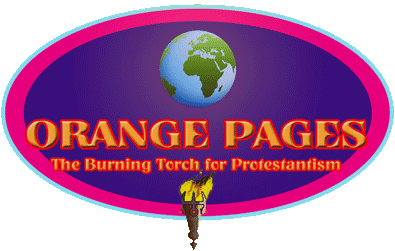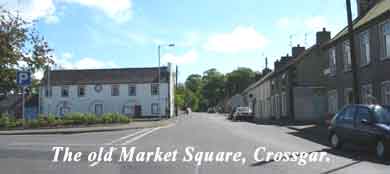|
The Whiteboys were a mid-18th Century pro-Irish
Secret Society. After 1815 they were known by different names such as
the Carders, Terry alts, Rockites, Whitefeet and in the song Boys of Crossgar
they are called the Thrashers. Many Orange songs of the period suggest
that the police were sympathetic to the Thrashers and turned a blind eye
to numerous skirmishes in County Down. This particular riot happened near
Castlewellan, co. down in July 1849, shortly before the Battle of Dolly`s
Brae.
The rise of the Orange Order from 1795 brought
about the rise of the Defenders to oppose them. Following on from skirmishes
in other areas, The Defenders or Ribbonmen (Catholics) decided on a show
of strength on St Patrick's Day; to march up Killyleagh Street, regarded
in Crossgar as a Protestant enclave. The Potato Famine of 1845/46 and
the lack of help from the British to alleviate the problem also added
to the discontent. Since the 1830s, Crossgar had been plagued by faction
fights, usually at Easter and Christmas. The population of the town was
evenly divided between Protestants and Catholics both trying to establish
'no-go' areas.
The word Ribbonmen came from an attempted coup d'etat at Garvagh at Lammas
Fair in July 1813.To identify themselves they wore large white handkerchiefs
or ribbons around their waists.
On St.Patrick's Day in 1849, Ribbonmen from Lecale, Saul, Strangford,
Ardglass, Annacloy and Teconnaught, with drums and banners, marched to
a prearranged meeting in Crossgar. At 11am, companies of Threshers or
Ribbonmen, passed through Downpatrick,where some slight rioting took place
and some locals threw stones.In retribution for this,they targeted the
Skillen home, 4km out of Downpatrick where the road to Crossgar turns
to the right. Damage was done to the windows and doors, furniture and
crockery broken and the front door was riddled with shot, which lends
support to the police claim that some of the Threshers were armed.
The procession then proceeded via Annacloy and Kilmore where an attack
was made on the premises of the Seay brothers, spirit grocers and general
merchants in the village. Shot was fired at the door and the bread delivery
van was demolished by large stones. Police had been strengthened to a
force of 60 by sub-inspector Despard from Navan. Behind the police line
in Killyleagh Street,crows of Orange and Protestant supporters chanted,"up
this street they must not walk." Anticipating trouble, three magistrates
were in attendance. They were Messrs. James Sharman Crawford, William
R. Anketell and J.L. McCance. Thirty Police were sent to Rea's corner
in attempt to block access to Killyleagh Street via William Street. This
weakening of police strength may have contributed to the events which
followed.
As the parade was turning the corner of Widow Boyd's public house much
pushing and shoving occurred; but it was not until a sixteen year old
lad called Cleland, left the Killyleagh Street party, ran across the street
and attempted to drag a collarette off a young man n the procession, that
events deteriorated. As Cleland and the drummer tussled over possession
of the sash, Constable Bradley of the Crossgar Barracks and two other
officers, ran over to separate them.Each opposing side saw this as an
attack upon their own party so stone throwing increased and shots were
heard. Each side was armed and the gunfire increased. Police were ordered
to load their guns to protect themselves.
Full scale rioting now appeared to escalate beyond control and at this
point Mr. Anketell read the Riot Act. The tragedy of this melee was the
death of a police constable called Bourke from Newtownbreda, who was shot
through the neck and killed instantly and a young lady called Ann Woods
who was assisting her father at his ginger bread stall. Another innocent
bystander called Smyth was also shot and died later in Down Infirmary.
Under attack from both sides, the police were ordered to open fire with
about thirty rounds fired.
At the inquest in the Market House into the deaths two days later, evidence
was given that both sides were armed and bullets were flying in all directions.
The coroner counselled the jury to bring down an open verdict on the deaths
but added that the procession was unlawful. He blamed the government for
not passing legislation suppressing these types of processions which are
the " bane and curse of this country".
On 14th April 1849 at Killyleagh Petty Sessions, 23 persons were summoned
for being engaged in an illegal and riotous assembly in Crossgar and Kilmore
on 17th March 1849. Constable Bradley identified for of the prisoners:
John McGuire,Hugh McClurg, John Burns and John McCauley as being armed
with guns and stated that the number assembled was between two to three
thousand. John Bell identified John, Daniel and Peter Rogan, proved that
they were armed and alleged that he saw two of them fire in the direction
of the police.
On 4th April 1849,some sixty defendants appeared and were examined at
a special court at Killyleagh, as a result of which 27 were sent for trial
at the Quarter Sessions at Newtownards.Of a further 25 persons who appeared
at Killyleagh on 28th April 1849, 8 were "held to bail" to stand
trial at Newtownards,making a total of 35 persons tried for taking part
in a riot.
( by Tom Hewitt 12 Mar 2003)
|



![]()